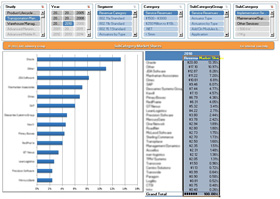

The Artificial Lift Optimization market research report delivers current market analysis plus a five-year market and technology forecast. This report provides a concise analysis of the artificial lift optimization market. The scope of the research is primarily on the upstream oil & gas production optimization opportunity. The study is available in multiple editions including worldwide, all regions, and most major countries.
Companies face continued challenges to raise productivity, lower production costs, lower oil extraction and refinement costs, reduce manufacturing operating expenses, and increase return on investment in order to compete in the global market. Optimizing artificial lift system performance and up-time can play a critical role in helping companies realize operational excellence.
The artificial lift optimization market, including hardware, software, and services, is somewhat dynamic with major segments experiencing strong product innovation. This market has tremendous opportunities with steady growth driven by a growing number of unconventional wells which are exhibiting greater decline rates, and wells which require artificial lifts to be deployed earlier in the life of the well. These artificial lift optimization solutions provide new features and functionality necessary to increase production and pump availability by leveraging smart sensors and machine learning based on industrial IoT.
The drive for well production growth, for which artificial lift optimization is critical, is pushing companies to invest in new optimization solutions and services including digitalization, industrial IoT, and Industry 4.0., for deployment at various project locations and formations. Furthermore, the advances in data quality, software processing, and ease of use, continue to increase the value proposition for end users.
 In addition to providing a five-year market forecast, the Artificial Lift Optimization market research report provides detailed quantitative current market data and addresses key strategic issues for both suppliers and potential buyers of these systems.
In addition to providing a five-year market forecast, the Artificial Lift Optimization market research report provides detailed quantitative current market data and addresses key strategic issues for both suppliers and potential buyers of these systems.
Companies operating artificial lift systems in oilfields continue to face the challenges of increasing production, reducing energy consumption, lowering costs per barrel, and maintaining pump operational uptime (i.e., minimizing downtime). Investing in artificial lift optimization across all seven artificial lift system types covered has benefited most users. The artificial lift optimization market has requirements, standards, and capabilities that vary by region, project location, and application. The study addresses the unique requirements and standards for artificial lift systems used by owner-operators, independent E&P firms, and other stakeholders.
While the COVID-19 pandemic did not impact the 2019 demand for artificial lift optimization, the market projections do take into account industry trends with our best estimates for how the COVID-19 pandemic will impact the artificial lift optimization market in different project locations and regions.
This market study may be purchased as an Excel Workbook and/or as a a concise, executive-level Market Analysis Report PDF File. The Workbook has some unique features such as the ability to view data in local currency. Regional studies include country and industry market data. Country studies include market trends and industry data. Studies and formats available are listed below:
| MIRA Workbook | Market Analysis PDF | |
| Worldwide (includes regional data) | Yes | Yes |
| North America (includes country data) | Yes | No |
| Latin America (includes country data) | Yes | No |
| Europe, Middle East, Africa (includes country data) | Yes | No |
| Asia (includes country data) | Yes | No |
| Country Profiles (includes country data) | No | Yes |
Countries included in each region.
Table of contents for these studies is shown in the following paragraphs.
The research identifies all relevant suppliers serving this market.
List of countries included in each region: MIRA-Country
Contact us for the countries available for this study.

